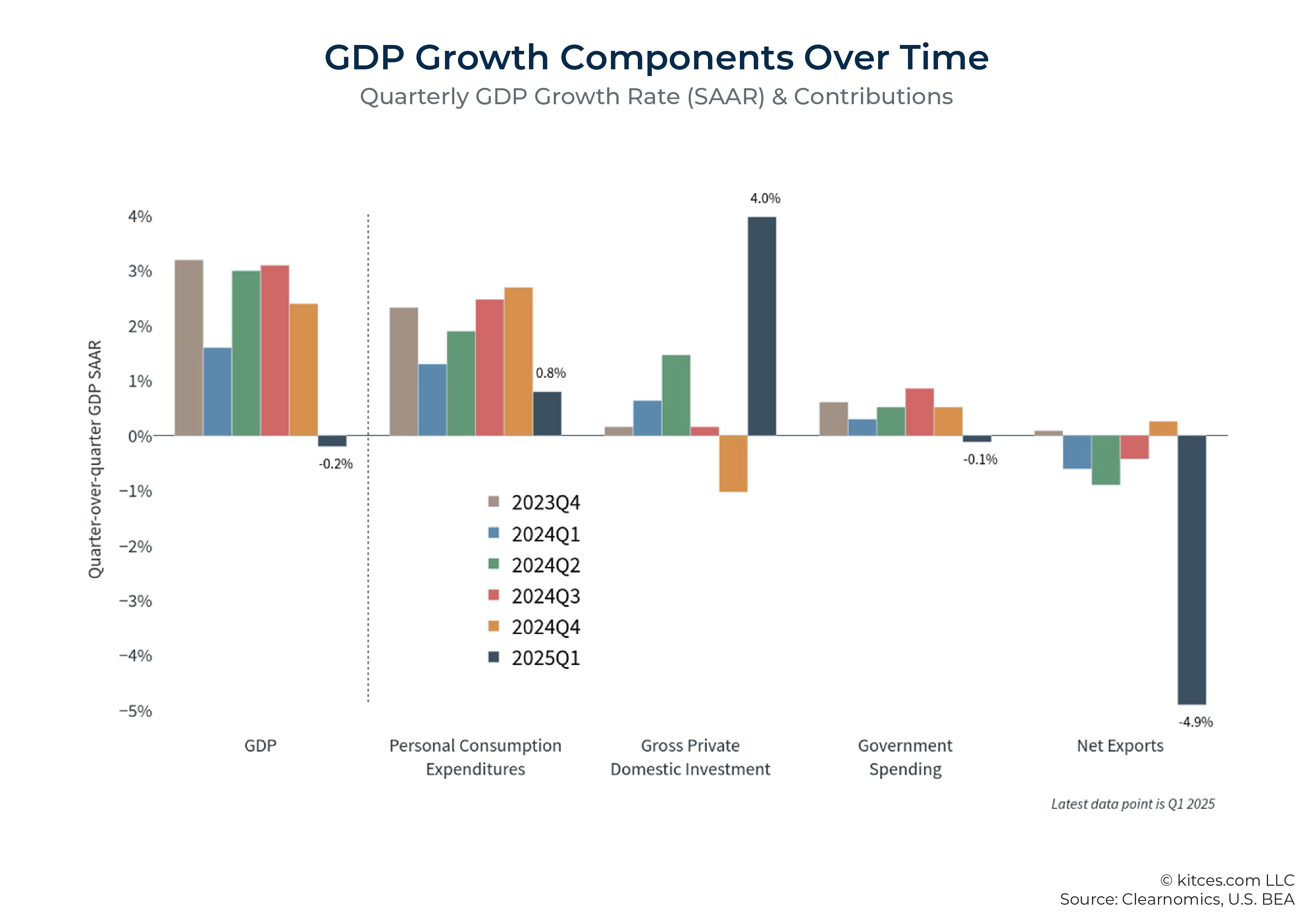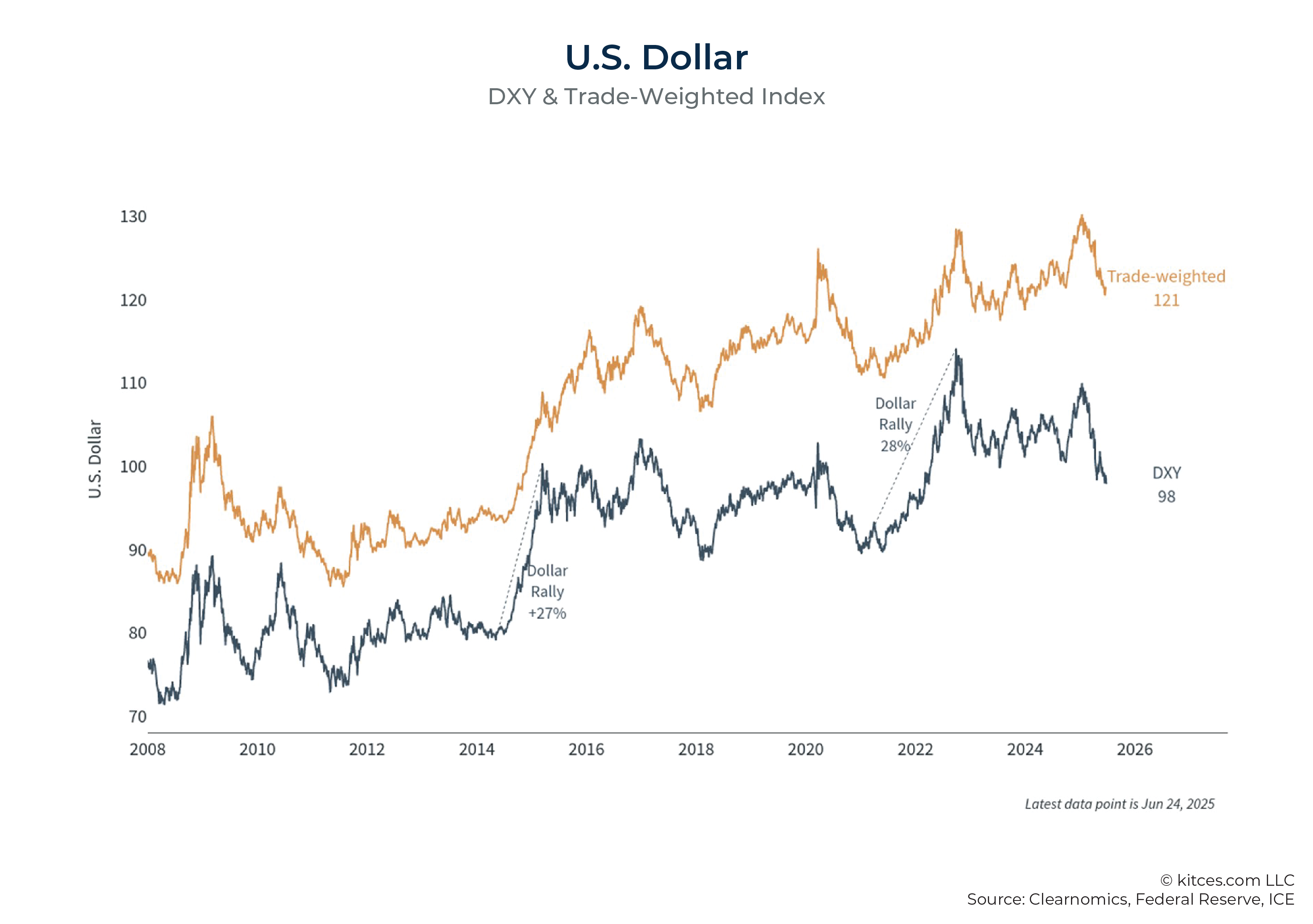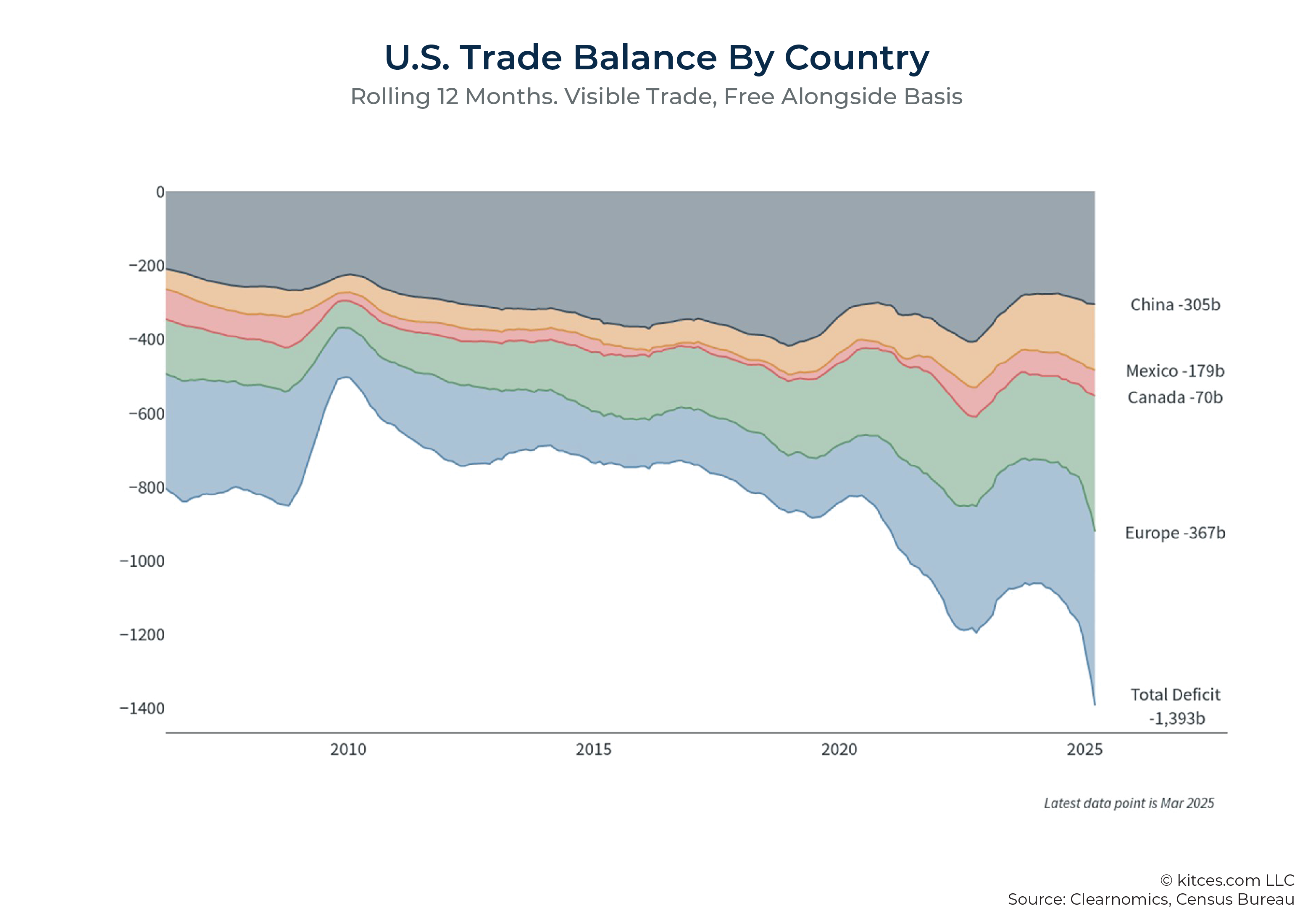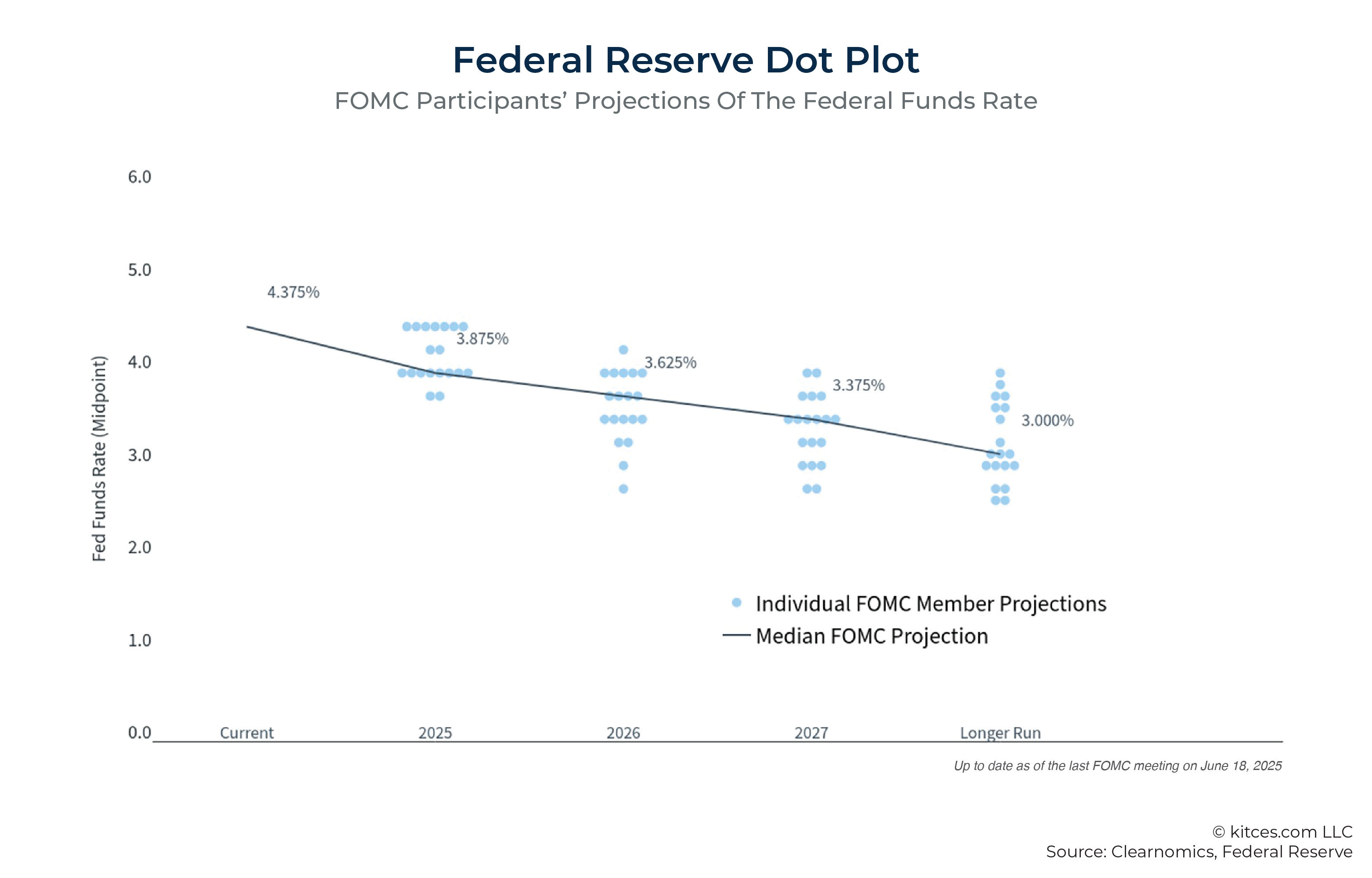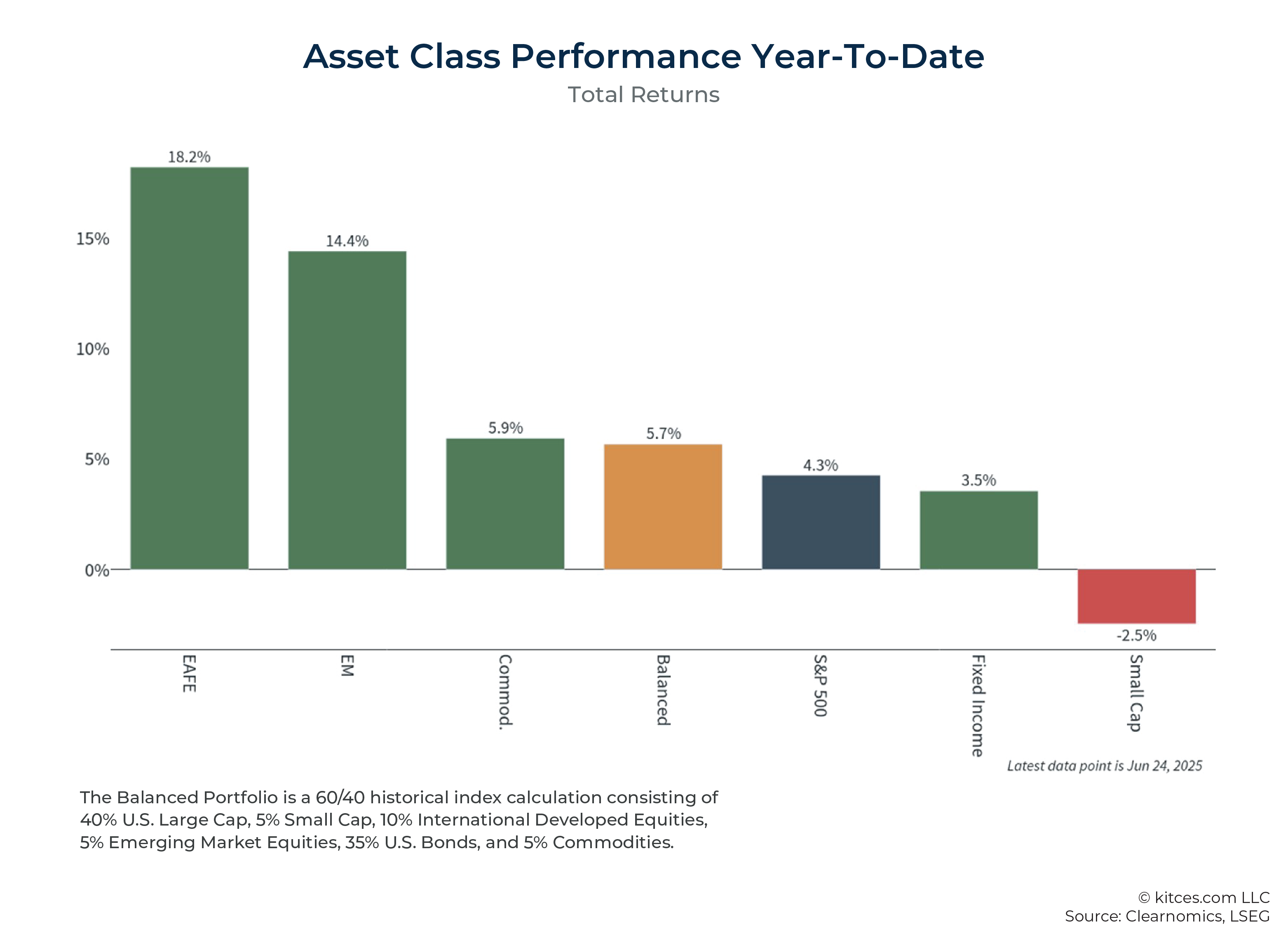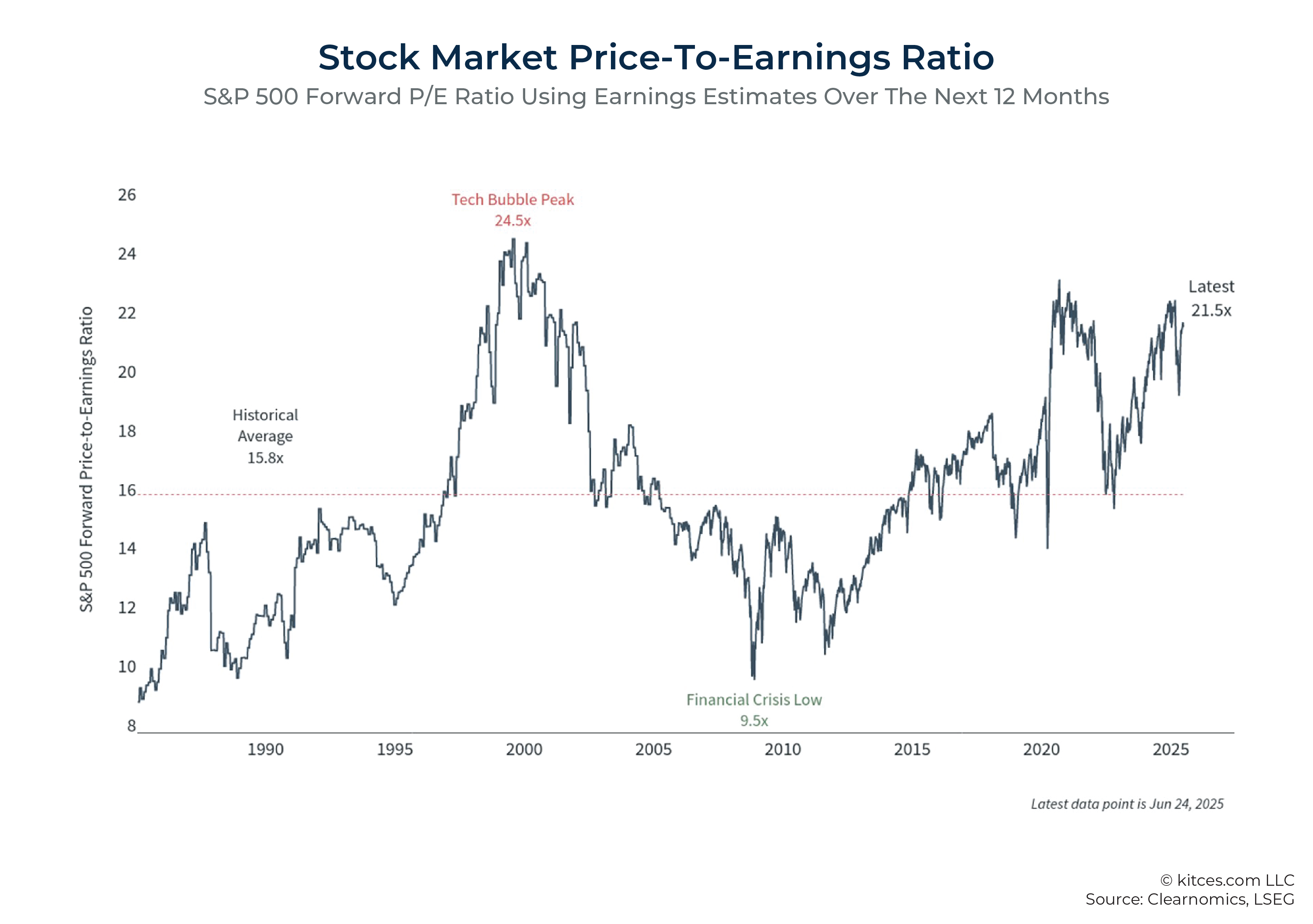Executive Summary
The first half of 2025 has been a wild ride, both in terms of news headlines and market movements. From tariffs, a market correction, and an escalating conflict in the Middle East to the dollar reaching a three-year low, the investment landscape presented many reasons for concern. Nonetheless, the market has staged one of the fastest recoveries in history, and the S&P 500 is hovering near all-time highs despite seeing its year-to-date return falling to a low of -15.3% in April.
In this guest post, James Liu, CEO and founder of Clearnomics, offers an analysis of nine key questions that could be relevant for upcoming client conversations, from the potential economic and market impact of tariffs to the Federal Reserve's views on interest rates and their future direction.
One of the major news topics during the first half of the year was the ups and downs of U.S. tariff and trade policy, with President Trump announcing a set of increased tariffs on a wide range of countries, then pausing or reducing some while keeping overall tariff levels higher than before he assumed office in January. While the U.S. stock market has rebounded following the partial tariff easing, some clients might be wondering whether the ongoing tariff saga will induce a recession. So far, though, the U.S. economy has been resilient, with encouraging inflation trends and unemployment remaining relatively low. And while the first quarter saw a negative GDP figure, this appears to be due in large part to a surge in imports ahead of expected tariffs.
Always a subject of intrigue, the Federal Reserve has received significant attention this year as market participants await expected rate cuts. So far, the Fed has maintained its key policy rate – the federal funds target range – at 4.25% to 4.50%, demonstrating a measured approach to monetary policy. While the Fed will likely balance potential future weakness in economic growth against possible tariff-induced inflation when making rate decisions, the general consensus among Fed officials continues to be that there could be two rate cuts in 2025.
Looking beyond the United States, some clients might be concerned that global affairs – such as the ongoing conflicts in the Middle East – could affect their portfolios. So far, though, markets have largely shrugged off geopolitical concerns, with international stocks outpacing their U.S. counterparts so far this year (rewarding investors who maintained allocations to international stocks) and oil prices remaining at relatively low levels.
In terms of valuations, current multiples for the S&P 500 remain above historical averages, even after the earlier market correction, which suggests less room for error as stocks become more sensitive to disappointments in earnings or growth projections. In this environment, some investors might favor sectors or segments that offer reasonable value relative to expected growth, which has helped drive increased interest in international markets, small- and mid-cap stocks, and value-oriented sectors trading at more attractive multiples. At the same time, fixed-income markets continue to have valuations that look very reasonable, providing a positive balance to diversified portfolios.
Ultimately, the key point is that amid the range of economic and market developments in the first half of 2025, investors who have stayed the course and maintained diversified portfolios have been rewarded with positive returns. Which could serve as an opportunity for advisors to demonstrate to their clients how they have positioned their portfolios appropriately for their unique investment timeframes and financial goals!
It's thought that Winston Churchill once said, "the pessimist sees difficulty in every opportunity, the optimist sees opportunity in every difficulty." This quote perfectly characterizes the first half of 2025.
Challenges have been abundant. From tariffs, a market correction, an escalating conflict in the Middle East, and the dollar reaching a three-year low, the investment landscape presented many reasons for concern.
Yet the market has staged one of the fastest recoveries in history. Although the S&P 500's year-to-date return fell to a low of –15.3% on April 8, it then rallied 18.6% through the end of May. And with the index once again approaching its all-time highs, investor sentiment has improved after reaching multi-decade lows. Those who stayed invested and took advantage of market opportunities amid the volatility are likely better positioned to meet their financial goals today.
While there is still uncertainty ahead, now is the perfect time for advisors to have meaningful conversations that remind clients of core investment and financial planning principles. For long-term investors, understanding the key themes shaping today's environment can help maintain perspective and guide effective portfolio decisions. And for advisors, being able to communicate a strong, thoughtful message on current issues helps provide value to clients across all market environments.
In this spirit, we've broken down the current market and economic environment into nine core questions to help frame a mid-year market outlook for clients. We've included client-friendly charts and visuals to support these conversations – whether in face-to-face meetings, hosting a webinar, or casual check-ins to answer one-off questions.
If you'd like to access the accompanying charts, you can download them as a PDF here.
Will Tariffs Cause A Recession?
While some advisors may feel that economic topics are too technical for certain clients, the reality is that these concepts affect nearly every aspect of a client's financial plan. Even when they don't come up in conversation, many clients may still worry about them. Educating clients by providing perspective and discussing trends – not by sharing every last fact and figure – can give them context to help them make better-informed decisions and set them up for future success. Educating clients in this way is a skill that adds real value.
This is particularly relevant today, since it's no secret that this year's market uncertainty has been driven by economic policy and geopolitics. This volatility has carried across both stocks and bonds:
- Equity volatility, as measured by the VIX index, has oscillated above historical norms in 2025, reaching a high of 52.3 in the peak of the tariff announcements, and sits just under 20 as we enter the mid-year point. These are above the long-run average of 18.4 going back 15 years.
- Bond volatility, as measured by the ICE BofA MOVE Index, has been consistently above the long-run average, although has settled more recently – hovering around 95 compared to a long-run average of 87.
Even with the recent market rebound, investors are still trying to absorb many important developments, including the future of tariffs, the path of Fed policy, the effect of Middle East conflicts on oil prices, government spending policy, and much more. The common thread to these issues is their impact on consumers and businesses, especially when it comes to inflation and growth.
The first quarter of 2025 saw GDP contracting at an annualized rate of 0.2% – the first negative reading in three years. While this is worrisome, the components of GDP make it clear that this was primarily caused by increased imports ahead of tariffs. As the accompanying chart above shows:
- "Gross private domestic investment" (business spending) spiked by 4%, a dramatic increase from prior levels due to business stockpiling goods, adding to GDP.
- This was offset by Net Exports declining significantly by 4.9%, due mostly to this import activity.
- Importantly, consumer spending, which is the backbone of the economy, is still positive and grew 0.8% for the quarter. This is weaker than in prior quarters, but it was not as bad as some feared.
Despite the negative GDP figure, the underlying fundamentals of the U.S. economy remain resilient. While consumer spending has slowed, it still remains the foundation of economic growth. Supporting consumer spending, the labor market remains a bright spot, with unemployment at only 4.2%, hovering within a narrow range between 4.0% and 4.2% for the past year.
Inflation trends have also been encouraging. As of May, the Consumer Price Index rose just 2.4% year-over-year, down from higher levels earlier in the year – and is slowly trending toward the Federal Reserve's 2% target. Core inflation, which excludes food and energy components, accelerated to a 2.8% year-over-year increase. However, shelter costs were the biggest contributor to this figure; excluding this category results in what's sometimes referred to as "supercore inflation", which rose only 1.9% year-over-year.
So, should we be worried about a recession? The combination of stable employment, moderating inflation, and a trade-driven GDP contraction likely reflects an economy in transition – not crisis. While growth may be slower than in previous years, these conditions suggest that the foundations of the economy are still likely healthy.
Will U.S. Exceptionalism Continue?
For many Americans, there's growing concern about whether the U.S. could lose its position in the world. Headlines about rising national debt, political battles, the declining dollar, and geopolitical unrest, naturally raise questions about the future of the U.S. economy and stock market.
These concerns are often framed around the idea of "American exceptionalism" – the belief that the U.S. is unique in the world and across history due to its political and economic systems, and in the values that have historically supported its strength. Recent developments have raised legitimate questions about the long-term durability of that exceptionalism.
Specifically, the U.S. continues to face real long-term challenges tied to the national debt and persistent deficits. Moody's recent downgrade of the U.S. credit rating from Aaa to Aa1 follows similar moves by Fitch in 2023 and Standard & Poor's in 2011 – each reflecting growing concerns about the nation's fiscal trajectory.
These conversations often touch on deeply held views, so they may require sensitivity. Clients may have strong perspectives, and advisors may have their own strong views as well. Moody's cited concerns that likely echo what many clients are already thinking. That is, the failure of successive administrations and Congress to agree on measures to reverse large annual fiscal deficits and growing interest costs.
Current budget proposals, still currently under consideration in Congress, could add an estimated $3 trillion or more to the national debt over the next decade, despite including trillions in spending reductions through changes to programs like Medicaid and nutrition assistance.
For some, a gauge of U.S. exceptionalism is the level of the dollar. Its decline this year is often seen as representing a flight from U.S. assets, especially during recent periods of volatility. However, at just below 100, the Dollar Index (DXY) is still within the range of the past few years. Zooming out more, the dollar is still near its strongest levels since 2008, as shown in the chart below. Meanwhile, the trade-weighted dollar index has also fallen but remains higher. This index measures the U.S. dollar's value relative to foreign currencies weighted according to the amount of trade the U.S. conducts with each country.
When it comes to investing and financial planning, it can be helpful to stay focused on what directly affects portfolios. Despite these fiscal concerns, the U.S. continues to demonstrate economic resilience that distinguishes it from other major economies. In times of crisis, investors still seek the safety of the U.S. dollar and Treasuries. While this shouldn't be taken for granted – and there have been exceptions – making investment decisions based on these concerns could lead to counterproductive outcomes.
This is because the depth and liquidity of U.S. financial markets, the relative stability of its institutions, and the dollar's central role in international trade all help to maintain its safe-haven status. Even after past credit downgrades since 2011, U.S. Treasury securities continue to serve as a benchmark for global fixed-income markets.
U.S. exceptionalism will ultimately boil down to concepts such as innovation, business quality, and earnings growth. Despite the challenges, there are many reasons to remain positive.
How Can Investors Navigate Tariffs And Geopolitics?
Clients ultimately want to know that their finances are in good order so negative surprises and uncertainty can create portfolio concerns.
The Economic Policy Index surpassed its pandemic peak in April, plus it remains elevated at around 309 (compared to a historical average of 109) due to geopolitics and fiscal concerns. This is where risk management becomes an important pillar of portfolio outcomes.
The wide range of potential outcomes from tariff policies, in particular, has created uncertainty that markets have found difficult to price. In many cases, these tariffs serve as negotiating tactics to strengthen positions on issues beyond trade – such as immigration and national security. This was demonstrated during the previous trade war period in 2018, when the administration aimed to secure new trade agreements with China, Mexico, Canada, and others.
Even so, the immediate impact on consumer sentiment and inflation expectations has still been significant. Survey data shows households are worried about higher prices for everyday goods and services. In some cases, individuals expect inflation rates that exceed even those experienced during the pandemic.
Geopolitical tensions beyond trade have added another layer of complexity. Ongoing conflicts in Eastern Europe and the Middle East, rising tensions in the South China Sea, and broader global power struggles continue to create uncertainty. These developments affect energy prices, potentially disrupt supply chains, and could act as a drag on global economic growth.
Oil prices, for example, have been volatile as the Israel-Iran conflict has escalated, swinging in both directions based on daily headlines. That said, the price of oil remains substantially below the 2022 peak of over $120 per barrel when Russia invaded Ukraine. This year alone, oil prices have varied between $60 and $82 per barrel.
Historically, markets have weathered similar periods of policy uncertainty and geopolitical stress. The key for long-term investors is maintaining perspective and avoiding overreaction to headlines, while ensuring portfolios are properly diversified to withstand various scenarios.
For advisors, this is a key opportunity to help clients understand that risks must be managed at all points in the cycle, not just against single events. If the market is already focused on a particular risk, such as wars or tariffs, market prices could already reflect it. That's when the power of diversification becomes most visible – and most valuable – during client conversations.
Will The Fed Cut Rates?
Federal Reserve policy continues to be an important factor in the market outlook. Policymakers face the difficult task of balancing competing economic pressures: On the one hand, tariffs may stoke inflation; on the other, a slowing economy may require monetary support.
This is another area where clients may have strong views and opinions, especially after enduring the recent period of high inflation and interest rates. For investors, the key takeaway is that we can't control what the Fed will do or where interest rates will go. What we can do is stay informed and adjust our plans based on the current outlook.
Fortunately, the Fed makes its thought process relatively transparent. Every quarter, it publishes its Summary of Economic Projections, offering insight into where policymakers see the economy heading. The latest release in June acknowledged increased uncertainty facing the economy while downgrading its 2025 economic growth forecast to 1.4%. This revision reflects concerns about the potential impact of trade policies, fiscal challenges, and global economic conditions.
So far this year, the Fed has maintained its key policy rate – the federal funds target range – at 4.25% to 4.50%, demonstrating a measured approach to monetary policy.
Looking ahead, Fed officials have emphasized their focus on underlying economic trends rather than short-term policy developments.
The general consensus of Fed officials continues to be that there could be two rate cuts in 2025. Based on the Fed's own projections, the Federal Funds Rate is also expected to fall further in 2026 and 2027, eventually reaching a longer-run rate of 3.0%. While that's not a guarantee or promise, it does suggest that policymakers believe conditions will improve.
The actual path of monetary policy will largely depend on how economic data evolves in the coming months. Key indicators, including employment, inflation, and consumer spending, will guide Fed decision-making as policymakers attempt to balance economic growth and price stability.
How Do International Stocks Fit In A Balanced Portfolio?
One of the most notable developments of 2025 has been the strong performance of international markets, which have significantly outperformed U.S. stocks.
This strength has been a welcome outcome for patient, diversified investors who've maintained international exposure. Developed and emerging market stocks – represented by the MSCI EAFE and MSCI EM indexes – have generated double-digit returns year-to-date. This performance stands in stark contrast to U.S. markets during the same period.
What's driving this outperformance? Several factors are at play: International valuations remain more attractive compared to elevated U.S. market multiples, economic conditions are improving in key regions, and the weakening U.S. dollar has created a beneficial currency tailwind. For U.S.-based investors, this means foreign assets have increased in value as local currencies strengthen relative to the dollar.
Market valuations remain favorable for international investors. The forward price-to-earnings ratio for the S&P 500 is elevated at 21.5X, compared to only 14.7X for developed markets (MSCI EAFE) and 12.5X emerging markets (MSCI EM), respectively, as of June 24. Emerging markets have shown particular strength as investors have become more optimistic about growth prospects in key regions. Countries like India and parts of Southeast Asia have attracted increased investment due to their demographic advantages, growing middle classes, and ongoing infrastructure development.
The rise of international markets underscores the importance of geographic diversification. While U.S. markets have dominated global returns for much of the past decade, periods of international outperformance serve as reminders that market leadership can shift over time. Ultimately, international investing isn't about generating better returns over days, weeks, or months. It's about building a strategic asset allocation that aligns with long-term return objectives and risk tolerance. International asset classes have unique characteristics that can potentially help support these goals – especially as market leadership continues to evolve.
What Is The Outlook For AI And The Magnificent Seven?
After driving market returns in recent years, the technology sector – and the group of large-cap companies known as the "Magnificent Seven" – has experienced significant volatility in 2025.
These companies – Apple, Microsoft, Amazon, Alphabet, Meta, Tesla, and Nvidia – have delivered cumulative returns of more than 300% since 2020, far outpacing broader market indexes. However, 2025 has presented a different narrative.
Technology stocks led market declines during the tariff-induced volatility earlier in the year, with investors reassessing growth expectations in an environment of heightened uncertainty. Concerns around AI infrastructure spending, rising competition, and regulatory scrutiny have weighed on the sector, contributing to its recent underperformance.
Despite recent challenges, though, these moves are best viewed within the context of the full cycle. The substantial gains achieved by these companies over the past several years demonstrate both their growth potential and their inherent volatility. For clients, this can serve as a clear example of how certain individual stocks and sectors can experience dramatic swings – even after strong performance.
Meanwhile, the artificial intelligence revolution continues to unfold. Companies across industries are investing heavily in AI capabilities. While the immediate market reaction to AI investments has been mostly positive, the challenge now is distinguishing between short-term hype and longer-term technological and economic trends that could reshape entire sectors. The transformative potential of AI remains strong, even as expectations continue to evolve.
Interestingly, the recent underperformance of technology stocks has coincided with stronger performance in other sectors, including energy, healthcare, utilities, and financials. Over the past year, eight of the eleven S&P 500 sectors have delivered positive returns despite recent market swings, reinforcing the benefits of sector diversification.
This rotation in market leadership highlights the importance of balanced portfolios. While technology stocks continue to play important roles in portfolios, their recent volatility serves as a reminder that concentration in any single sector or theme carries risks. Diversification allows portfolios to adapt to changing conditions, helping to support more stable long-term outcomes.
Is The Stock Market Expensive Right Now?
Valuations can be a powerful tool for client education. While they're not reliable for timing the market, they can provide important context for setting long-term return expectations and constructing appropriate portfolios.
As it stands, current market valuation multiples remain above historical averages, even after the earlier market correction. The S&P 500's forward price-to-earnings ratio is 21.5X as of June 24, well above the historical average of 15.8X and not far from the tech bubble peak of 24.5X in 1999. This reflects continued investor confidence in corporate earnings, which are expected to grow by about 11% for the S&P 500 in the next 12 months based on the implied growth rate.
The return to elevated valuation levels following the tariff-induced market pullback also demonstrates renewed investor risk appetite. However, these levels also suggest less room for error, as stocks become more sensitive to disappointments in earnings or growth projections.
In this environment, many investors become more selective, favoring sectors or segments that offer reasonable value relative to expected growth. That's helped drive increased interest in international markets, small- and mid-cap stocks, and value-oriented sectors trading at more attractive multiples.
At the same time, fixed-income markets have valuations that continue to look very reasonable, which provides a positive balance to diversified portfolios. Bond yields remain above long-term averages across sectors, from U.S. Treasuries to emerging-market debt. For multi-asset investors, this makes core bond exposure and valuations an important part of the 2025 narrative.
For clients with meaningful U.S. equity exposure, elevated valuations may signal more modest future returns than those experienced during the past decade's bull market. Markets trading at elevated multiples have historically shown increased sensitivity to economic data, policy changes, and earnings results, potentially leading to more pronounced price swings.
All of this reinforces a familiar but powerful message: Diversification across asset classes, sectors, and geographies remain essential. It not only spreads risk but helps capture returns from a broader range of opportunities.
What Opportunities Are There Amid Ongoing Uncertainty?
Despite elevated valuations in large-cap U.S. stocks, opportunities exist in other areas of the market that have been overshadowed during recent years of concentrated returns.
The broadening of market participation beyond the Magnificent Seven is a healthy development – and one that can provide new sources of portfolio returns.
Small and mid-cap companies often trade at more reasonable valuations and may benefit from improved economic conditions and reduced interest rate pressures. These companies tend to have greater exposure to domestic economic trends and may be less affected by international tensions.
Value-oriented sectors such as utilities, energy, and financials can also benefit during periods of market rotation. These sectors often offer more attractive dividend yields and may be supported by specific economic conditions such as higher interest rates or increased infrastructure spending. In fact, the dividend yield for the energy sector is 3.6%, utilities 3.1%, and financials 1.6%, versus the broad S&P 500 dividend yield of just 1.4% as of June 2025.
Emerging markets present compelling long-term opportunities in regions where economic growth prospects may exceed those of developed markets. Favorable demographics, urbanization, and improving governance continue to support expansion in many of these countries– particularly when combined with currency effects from a weakening dollar. Elsewhere, European and Asian markets offer exposure to different economic cycles and may provide attractive opportunities for patient investors.
Fixed-income markets also remain appealing, with bond yields still elevated compared to the past two decades. Corporate bonds are yielding 5.1% versus the 3.8% long-run average since 2009, and Treasury securities are yielding 4.1% versus a historical average of 2.1%. These assets can provide portfolio income while serving their traditional role as portfolio diversifiers.
In the current environment, maintaining a balanced approach is essential. Capturing opportunities across different asset classes while managing risks means thinking across asset classes, sectors, and regions – and being attentive to valuation differences across markets.
How Can Advisors Help Their Clients Prepare For The Second Half Of 2025?
As we begin the second half of 2025, several themes are likely to remain central to client conversations. The evolution of trade policy, Federal Reserve decisions, and international developments will continue to be key factors for advisors to monitor.
Importantly, there are many positive narratives at play. The resilience demonstrated by markets and the economy during the first half of the year suggests that fundamental strengths remain intact. Corporate earnings growth also remains very healthy, with expectations of approximately 11% for the coming year. While these forecasts are subject to revision, they suggest that underlying business fundamentals continue to support market valuations.
The broadening of market returns beyond a narrow group of technology stocks also represents another encouraging sign. This rotation may lead to more durable market leadership and open up new opportunities to support portfolio outcomes.
International market outperformance also serves as a reminder to clients of the benefits of global diversification. As U.S. market valuations remain elevated, international markets may continue to offer attractive opportunities for long-term investors.
The Federal Reserve's measured approach to monetary policy suggests that interest rate changes will be data-dependent and gradual. This environment may support continued economic growth while allowing markets to adjust to changing conditions.
Of course, clients will continue to keep a close eye on risks. Debt and deficit challenges, as well as currency concerns, are longer-term considerations that require monitoring but don't necessarily call for immediate portfolio adjustments. And while new risks will almost certainly present themselves, the U.S. economy's fundamental strengths continue to support its position in global markets.
The bottom line? 2025 has demonstrated that today's market environment is shaped by both challenges and opportunities. For long-term investors, maintaining a balanced approach – one that manages risk while capturing opportunities – remains the most prudent strategy to achieve financial goals. You can download all of the charts as a PDF here.


